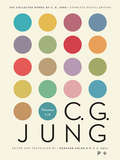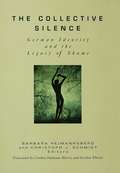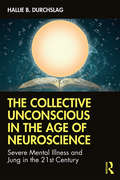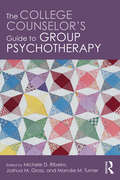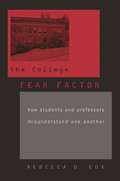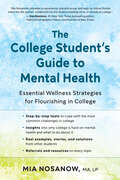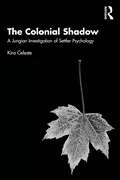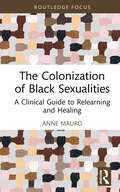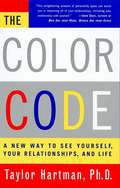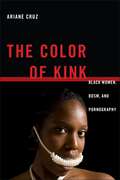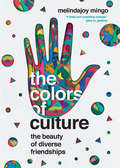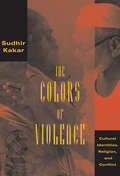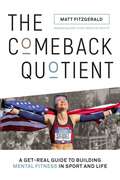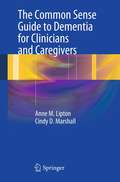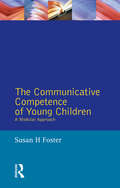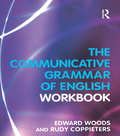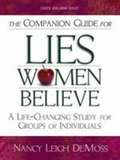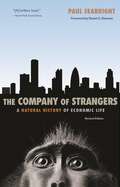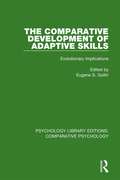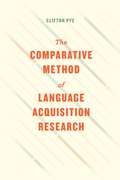- Table View
- List View
The Collected Works of C.G. Jung: Complete Digital Edition
by C. G. Jung William Mcguire R. F.C. Hull Gerhard Adler Michael Fordham Sir Herbert ReadFor the first time, The Collected Works of C. G. Jung are now available as individual e-books and as a complete digital set. Both the individual volumes and the set are full-text searchable. The main volumes, Vols. 1-18, are available for individual purchase. The set--available at a special introductory price of $499--includes Vols. 1-18 and Vol. 19, the General Bibliography of C. G. Jung's Writings. (It excludes Vol. 20, the General Index to the Collected Works.)
The Collective Silence: German Identity and the Legacy of Shame
by Barbara Heimannsberg Christoph J. SchmidtThe silence surrounding the Holocaust continues to prevent healing - whether of the victims, Nazis, or the generations that followed them. The telling of the stories surrounding the Holocaust - all the stories - is essential if we are to understand what happened, recognize the part of human nature that allows such atrocities to occur, and realize the hope that we can prevent it from happening again. Seeking to shed light on the collective silence surrounding the Holocaust in Germany, the contributors offer compelling accounts, histories, and experiences that illuminate the ways in which contemporary Germans continue to grapple with the consequences of the Holocaust. Denial in the older generations, as well as anger and confusion in the younger ones, comes vividly to the surface in these evocative stories of coping and healing. Told from the vantage points both of therapists and of patients, these stories encompass the psychological plight of all those facing the legacy of genocide - from the daughter of a high-ranking Nazi official to the children of Jewish immigrants, from those raised in the Hitler Youth Movement to those born well after the war.
The Collective Unconscious in the Age of Neuroscience: Severe Mental Illness and Jung in the 21st Century
by Hallie B. DurchslagThe Collective Unconscious in the Age of Neuroscience brings the connection between C. G. Jung’s theory of a collective unconscious, neuroscience, and personal experiences of severe mental illness to life. Hallie B. Durchslag uses narrative analysis to examine four autobiographical accounts of mental illness, including her own, and illuminate the interplay between psychic material and human physiology that Jung intuited to exist. Durchslag’s unique study considers the links between expressions of the collective unconscious, such as myth, fairy tales, folk tales, and ‘big dreams’, and the experiences of those diagnosed with severe mental illnesses, such as schizophrenia and bipolar disorder. The author’s personal narrative account of a psychotic episode is at its heart, bringing both an intimate foundation and exceptional insight to the book. With reference to neuroscientific and genetic research throughout, The Collective Unconscious in the Age of Neuroscience highlights the gap between depth psychological notions of etiology and treatment, highlights patterns of collective material in the qualitative experience of these genetic and biological disorders, and explores how the efficacy of pharmacological treatment sheds light on Jung’s theoretical model. The Collective Unconscious in the Age of Neuroscience will be essential reading for academics and students of Jungian and post-Jungian studies, consciousness, neuroscience and mental health. It will also provide unique insight for analytical psychologists interested in severe mental illness and the collective unconscious.
The College Counselor's Guide to Group Psychotherapy
by Michele D. Ribeiro Joshua M. Gross Marcee M. TurnerGroup psychotherapy in college counseling centers continues to thrive as a popular approach to working with college students, and yet there continues to be a lack of up-to-date, comprehensive resources for group psychotherapists working with this unique population. The College Counselor’s Guide to Group Psychotherapy highlights the role of the group therapist within college counseling centers; provides practical, step-by-step instructions for creating a thriving group program and culture; and unveils some of the opportunities to expand this under-recognized practice setting. This exciting new volume draws on the most current knowledge on group psychotherapy while paying particular attention to issues and ethical dilemmas that are unique to working with college students.
The College Fear Factor: How Students and Professors Misunderstand One Another
by Rebecca D. CoxThey’re not the students strolling across the bucolic liberal arts campuses where their grandfathers played football. They are first-generation college students—children of immigrants and blue-collar workers—who know that their hopes for success hinge on a degree. But college is expensive, unfamiliar, and intimidating. Inexperienced students expect tough classes and demanding, remote faculty. They may not know what an assignment means, what a score indicates, or that a single grade is not a definitive measure of ability. And they certainly don’t feel entitled to be there. They do not presume success, and if they have a problem, they don’t expect to receive help or even a second chance. Rebecca D. Cox draws on five years of interviews and observations at community colleges. She shows how students and their instructors misunderstand and ultimately fail one another, despite good intentions. Most memorably, she describes how easily students can feel defeated—by their real-world responsibilities and by the demands of college—and come to conclude that they just don’t belong there after all. Eye-opening even for experienced faculty and administrators, The College Fear Factor reveals how the traditional college culture can actually pose obstacles to students’ success, and suggests strategies for effectively explaining academic expectations.
The College Student’s Guide to Mental Health: Essential Wellness Strategies for Flourishing in College
by Mia NosanowEasy, accessible guidance for addressing an essential element to college success: mental health While being in college can be an exciting time, it can also be a period of uncertainty, anxiety, loneliness, and even depression. The College Student’s Guide to Mental Health is for any college student who wants to understand and maintain mental and emotional health. Mia Nosanow, a licensed psychologist and college therapist, has drawn upon her more than twenty years of direct experience counseling a diverse college student body to write a comprehensive mental and emotional health manual designed specifically for college students. Presented in clear, practical language and organized in short chapters, this book breaks down common problems and provides actionable strategies for addressing them. Whether students want to understand challenging emotions, transform negative thoughts, improve relationships, or explore the connection between time management and mental health, these topics and more can be found in this one book — a valuable tool for college students as well as the families and professionals who support them.
The Colonial Shadow: A Jungian Investigation of Settler Psychology
by Kira CelesteThe Colonial Shadow examines the colonial psychology that has shaped what is now known as Canada. This psychology has perpetrated devastating harm over the last half a millennium and continues to oppress Indigenous people and degrade the environment. This book is inspired by the tenet of depth psychology that stories and myths from one’s own ancestry can bring about transformation and deep changes in perspective. As such, it investigates how an alchemical way of imagining into white settler colonial consciousness might contribute to its accountability and psychological healing today. The Colonial Shadow will be an invaluable resource for professionals, academics and students of Jungian and post-Jungian ideas, settler-colonial and First Nations studies, sociology, anthropology, and cultural studies as well as for anyone interested in addressing the colonial complex.
The Colonization of Black Sexualities: A Clinical Guide to Relearning and Healing (Leading Conversations on Black Sexualities and Identities)
by Anne MauroAnne Mauro invites therapists to look through a historical lens to view how the harmful effects of colonization and white supremacy impact their Black client’s sexuality in the modern day. Written from her unique position as a sex therapist and bi-racial Black woman, Mauro believes that by relearning the history of sexual trauma on African American bodies, clinicians can better assess their client’s intergenerational trauma and inform their work and practice. Chapters address how the patriarchy was an agent in colonization, the impact of colonization on ethnosexuality, slavery, and sexuality, ethnosexual historical traumas and their impact on modern day American sexual behavior, and the continuing effects of sexual violence and sexual health disparities in young Black women and girls. With reflective questions woven throughout, the final chapter guides the therapist through clinical practices meant for grounding, healing, and the promotion of authenticity within this work. It offers tangible insights into dismantling oppressive practices and integrating the material into the reader’s personal and professional lives. The book is essential reading for students of gender studies, human sexuality, and race studies, as well as all mental health professionals, such as sex therapists, marriage and family therapists, and clinical social workers.
The Color Code: A New Way to See Yourself, Your Relationships, and Life
by Taylor HartmanDISCOVER YOUR TRUE COLOR(S) WITH THE COLOR CODE -- AND UNLOCK YOUR POTENTIAL FOR SUCCESS AT WORK AND AT HOME Go ahead, take the test, and find out what makes you (and others) tick. By answering the 45-question personality profile, you will no doubt gain insight and illumination that will start you out on a thrilling journey of self-discovery while you: * Identify your primary color * Read others easily and accurately * Discover what your primary motivators are * Identify and develop your natural strengths and transform your weaknesses * Improve your relationships with yourself and others * Enhance your business performance The Color Code will, quite simply, change your life. It is guaranteed to make a difference in every relationship you have, starting with the relationship you have with yourself.
The Color of Kink: Black Women, BDSM, and Pornography (Families, Law, and Society #26)
by Ariane CruzA study of how BDSM can be used as a metaphor for exploring black female sexuality. The Color of Kink explores black women's representations and performances within American pornography and BDSM (bondage and discipline, domination and submission, and sadism and masochism) from the 1930s to the present, revealing the ways in which they illustrate a complex and contradictory negotiation of pain, pleasure, and power for black women. Based on personal interviews conducted with pornography performers, producers, and professional dominatrices, visual and textual analysis, and extensive archival research, Ariane Cruz reveals BDSM and pornography as critical sites from which to rethink the formative links between Black female sexuality and violence. She explores how violence becomes not just a vehicle of pleasure but also a mode of accessing and contesting power. Drawing on feminist and queer theory, critical race theory, and media studies, Cruz argues that BDSM is a productive space from which to consider the complexity and diverseness of black women's sexual practice and the mutability of black female sexuality. Illuminating the cross-pollination of black sexuality and BDSM, The Color of Kink makes a unique contribution to the growing scholarship on racialized sexuality. Winner of the MLA&’s 2016 Alan Bray Prize for Best Book in LGBTQ Studies
The Colors of Culture: The Beauty of Diverse Friendships
by MelindaJoy Mingo05How diverse are your friendships? We are living in a time where fear and mistrust among people of different cultural and ethnic groups is becoming the norm rather than the exception. It appears that cultural and racial divides are expanding rather than shrinking. What can we do? We can learn to see every human being from God's perspective and value their experiences even when we don't understand them. To truly connect with people who are different from us will take the grace of God, compassion, and empathy. It will mean risking everything that we think we know about other cultures to initiate small steps toward befriending others. In The Colors of Culture, MelindaJoy Mingo models reaching across cultures. Through vivid stories spanning several countries, Mingo shows the beauty of diverse friendships in her life. She takes risks and learns from her mistakes, recognizing that relationships are worth the cost.
The Colors of Grief: Understanding a Child's Journey through Loss from Birth to Adulthood
by Janis Di CiaccoFollowing a life shattering experience, a child enters upon a confusing emotional journey that can be likened to a prism of many colors of dark feelings like sadness and fear, but also warm feelings of love and courage. The way they deal with these feelings has a lasting impact on their life as they grow. The Colors of Grief explores strategies for supporting a grieving child to ensure a healthy growth into adulthood. Drawing on the latest research in neurology and psychology, Janis Di Ciacco illustrates the child's grieving process using a model of development that employs `key stages'. These range from preverbal infancy (0-2 years) through to early adulthood (about 25 years). She shows how a child's progress through these stages can be impaired by an early encounter with loss, which can contribute to cognitive, emotional and social difficulties. Drawing connections between bereavement, attachment issues and social dysfunction, the author suggests easy-to-use activities for intervention at each key stage, including infant massage, aromatherapy and storytelling. This is a revealing and accessible book for both parents and professionals working with, or caring for, bereaved infants, children or young adults.
The Colors of Violence: Cultural Identities, Religion, and Conflict
by Sudhir KakarFor decades India has been intermittently tormented by brutal outbursts of religious violence, thrusting thousands of ordinary Hindus and Muslims into bloody conflict. In this provocative work, psychoanalyst Sudhir Kakar exposes the psychological roots of Hindu-Muslim violence and examines with grace and intensity the subjective experience of religious hatred in his native land. With honesty, insight, and unsparing self-reflection, Kakar confronts the profoundly enigmatic relations that link individual egos to cultural moralities and religious violence. His innovative psychological approach offers a framework for understanding the kind of ethnic-religious conflict that has so vexed social scientists in India and throughout the world. Through riveting case studies, Kakar explores cultural stereotypes, religious antagonisms, ethnocentric histories, and episodic violence to trace the development of both Hindu and Muslim psyches. He argues that in early childhood the social identity of every Indian is grounded in traditional religious identifications and communalism. Together these bring about deep-set psychological anxieties and animosities toward the other. For Hindus and Muslims alike, violence becomes morally acceptable when communally and religiously sanctioned. As the changing pressures of modernization and secularism in a multicultural society grate at this entrenched communalism, and as each group vies for power, ethnic-religious conflicts ignite. The Colors of Violence speaks with eloquence and urgency to anyone concerned with the postmodern clash of religious and cultural identities.
The Colors of Violence: Cultural Identities, Religion, and Conflict
by Sudhir KakarFor decades India has been intermittently tormented by brutal outbursts of religious violence, thrusting thousands of ordinary Hindus and Muslims into bloody conflict. In this provocative work, psychoanalyst Sudhir Kakar exposes the psychological roots of Hindu-Muslim violence and examines with grace and intensity the subjective experience of religious hatred in his native land. With honesty, insight, and unsparing self-reflection, Kakar confronts the profoundly enigmatic relations that link individual egos to cultural moralities and religious violence. His innovative psychological approach offers a framework for understanding the kind of ethnic-religious conflict that has so vexed social scientists in India and throughout the world. Through riveting case studies, Kakar explores cultural stereotypes, religious antagonisms, ethnocentric histories, and episodic violence to trace the development of both Hindu and Muslim psyches. He argues that in early childhood the social identity of every Indian is grounded in traditional religious identifications and communalism. Together these bring about deep-set psychological anxieties and animosities toward the other. For Hindus and Muslims alike, violence becomes morally acceptable when communally and religiously sanctioned. As the changing pressures of modernization and secularism in a multicultural society grate at this entrenched communalism, and as each group vies for power, ethnic-religious conflicts ignite. The Colors of Violence speaks with eloquence and urgency to anyone concerned with the postmodern clash of religious and cultural identities.
The Colors of Violence: Cultural Identities, Religion, and Conflict
by Sudhir KakarFor decades India has been intermittently tormented by brutal outbursts of religious violence, thrusting thousands of ordinary Hindus and Muslims into bloody conflict. In this provocative work, psychoanalyst Sudhir Kakar exposes the psychological roots of Hindu-Muslim violence and examines with grace and intensity the subjective experience of religious hatred in his native land. With honesty, insight, and unsparing self-reflection, Kakar confronts the profoundly enigmatic relations that link individual egos to cultural moralities and religious violence. His innovative psychological approach offers a framework for understanding the kind of ethnic-religious conflict that has so vexed social scientists in India and throughout the world. Through riveting case studies, Kakar explores cultural stereotypes, religious antagonisms, ethnocentric histories, and episodic violence to trace the development of both Hindu and Muslim psyches. He argues that in early childhood the social identity of every Indian is grounded in traditional religious identifications and communalism. Together these bring about deep-set psychological anxieties and animosities toward the other. For Hindus and Muslims alike, violence becomes morally acceptable when communally and religiously sanctioned. As the changing pressures of modernization and secularism in a multicultural society grate at this entrenched communalism, and as each group vies for power, ethnic-religious conflicts ignite. The Colors of Violence speaks with eloquence and urgency to anyone concerned with the postmodern clash of religious and cultural identities.
The Combat Trauma Healing Manual: Christ-centered Solutions for Combat Trauma
by Chris AdsitThis book offers spiritual solutions for your struggles with Posttraumatic Stress Disorder (PTSD), by combining the latest insights of the medical and psychiatric communities with the timeless principles of God's Word.
The Comeback (Lorimer Sports Stories)
by Alex O'BrienOn the surface, fourteen-year-old Chris is pretty average, playing hockey and having friends. But underneath it all, Chris is depressed. He quits his hockey team, but his doctor suggests that he should pick up another sport. Chris starts playing soccer, and the positive benefits of sport start to take effect. But former hockey teammate Trent is on the team, and his suspicions about Chris and his mental health threaten Chris's acceptance and recovery. When Chris and Trent are chosen to play in a summer tournament, Chris decides to keep his depression a secret. But will rumors and stigma about his condition make him backslide and turn his own team against him? Find out in this sensitive high/low middle grade title. Distributed in the U.S by Lerner Publishing Group.
The Comeback Quotient: A Get-Real Guide to Building Mental Fitness in Sport and Life
by Matt FitzgeraldA good comeback makes a great story. In The Comeback Quotient, sports journalist Matt Fitzgerald shares the stories of top athletic comebacks, to give you inspiration and tools for your own comeback in sport or life.Every sports fan loves a great comeback. Is there a special quality shared by top athletes who triumph over great challenges? And can anyone acquire it? In The Comeback Quotient, celebrated sportswriter Matt Fitzgerald supplies the answer to both questions. He identifies these mega-achievers of astounding athletic comebacks as &“ultrarealists,&” men and women who succeed where others fail by fully accepting, embracing, and addressing the reality of their situations. From ultrarunners like Rob Krar to triathletes like Mirinda Carfrae to rowers, skiers, cyclists, and runners all over the world, Fitzgerald highlights and speculates on just what makes these comebacks so compelling. As for whether anyone can stage his or her own great comeback, the answer is a resounding yes: Anyone can become an ultrarealist to some degree. In the tradition of his best-selling How Bad Do You Want It?, The Comeback Quotient combines gripping sports stories with mind-blowing science to deliver a book that will forever change how you perceive the challenges you face, giving you the inspiration and the tools to make the next great comeback you witness your own.
The Common Sense Guide to Dementia For Clinicians and Caregivers
by Anne M. Lipton Cindy D. MarshallThe Common Sense Guide to Dementia for Clinicians and Caregivers provides an easy-to-read, practical, and thoughtful approach to dementia care. Written by two specialists who have cared for thousands of patients with dementia and their families, this ground-breaking title unifies the perspectives of neurology and psychiatry to meet a variety of caregiver needs. It spotlights many real-world concerns not typically covered in standard textbooks, while simultaneously presenting a more detailed medical perspective than typical caregiver manuals. This handy title offers expert guidance for the clinical management of dementia and compassionate support of patients and families. Designed to enhance the physician-caregiver interaction and liberally illustrated with case examples, The Common Sense Guide espouses general principles of dementia care that apply across the stages and spectrum of this illness, including non-Alzheimer's types of dementia, in addition to Alzheimer's disease. Clinicians, family members, and other caregivers will find this volume useful from the moment that symptoms of dementia emerge. The authors place an emphasis on caring for the caregiver as well as the patient. Essential topics include how to find the right clinician, make the most of a doctor's visit, and avert a crisis - or manage one that can't be avoided. Sometimes difficult considerations, such as driving, financial management, legal matters, long-term placement, and end-of-life care, are faced head-on. Tried, true, and time-saving tips are explained in terms of what works - and what doesn't - with regard to clinical evaluation, medications, behavioral measures, and alternate therapies. Medical, nursing, and allied health care professionals will undoubtedly turn to this unique overview as a vital resource and mainstay of clinical dementia care, as well as a valuable recommendation for family caregivers.
The Communicative Competence of Young Children: A Modular Approach (Studies in Language and Linguistics)
by Susan H. Foster-CohenHow children first acquire language is one of the central issues in linguistics. This book draws on a wide range of research, including work in developmental psychology, anthropology and sociology, to explore the processes behind child language acquisition to the preschool period.
The Communicative Grammar of English Workbook
by Edward Dr. Woods Rudy CoppietersThe companion text to A Communicative Grammar of English (CGE), this workbook presents an opportunity for practising the points raised in the main grammar. The units follow the order of sections in Part One and Part Two of CGE; at the beginning of each sub-unit there is a brief explanation of a particular structure followed by a series of tasks, ranging from gap filling exercises to rewrite assignments and conversational passages in which the student is invited to participate.? With authentic material and a variety of different task types graded by difficulty, this is an indispensable resource for teachers and advanced students with a good grounding in the grammar of the language.
The Companion Guide for Lies Women Believe: Life-changing Study for Individuals and Groups
by Nancy Leigh DemossThe Companion Guide for Lies Women Believe is made up of ten sessions and is designed for individuals and small groups. Each chapter includes the following features: In a Nutshell--gives you an overview of the chapter to be studied from Lies Women Believe and reminds you of the lies discussed within that chapter. Exploring the Truth--offers a daily personal study for you to complete during the course of the week between your small group meetings. Each day's study includes a few pages to read from Lies Women Believe and then questions to answer under the subtitles "Realize," "Reflect," and "Respond." Walking Together in the Truth--provides questions to be discussed when your small group meets. This engaging workbook will make you and your friends think and wrestle with the Truth as you search the Bible for answers to tough issues. The Companion Guide for Lies Women Believe is ideal for small groups, Bible studies, and Sunday school classes.
The Company of Strangers: A Natural History of Economic Life - Revised Edition
by Paul SeabrightThe Company of Strangers shows us the remarkable strangeness, and fragility, of our everyday lives. This completely revised and updated edition includes a new chapter analyzing how the rise and fall of social trust explain the unsustainable boom in the global economy over the past decade and the financial crisis that succeeded it. Drawing on insights from biology, anthropology, history, psychology, and literature, Paul Seabright explores how our evolved ability of abstract reasoning has allowed institutions like money, markets, cities, and the banking system to provide the foundations of social trust that we need in our everyday lives. Even the simple acts of buying food and clothing depend on an astonishing web of interaction that spans the globe. How did humans develop the ability to trust total strangers with providing our most basic needs?
The Comparative Development of Adaptive Skills: Evolutionary Implications (Psychology Library Editions: Comparative Psychology)
by Eugene S. GollinOriginally published in 1985, the aim of this book was to examine the development of adaptive skills in a comparative context. Comparative explorations have evolutionary implications. Thus it is inevitable that the contributors to this volume, all of whom come to the study of development with a comparative perspective, manifest concern with the relationships between ontogeny and phylogeny. In this volume both field and laboratory approaches are presented. It is quite clear that the laboratory studies are increasingly informed by ecological considerations that derive from field excursions. It is also the case that laboratory findings are becoming an essential source in directing field inquiries. The problems explored are theoretically rich and methodically significant and the comparative scope of the contributions range widely among vertebrate species.
The Comparative Method of Language Acquisition Research
by Clifton PyeThe Mayan family of languages is ancient and unique. With their distinctive relational nouns, positionals, and complex grammatical voices, they are quite alien to English and have never been shown to be genetically related to other New World tongues. These qualities, Clifton Pye shows, afford a particular opportunity for linguistic insight. Both an overview of lessons Pye has gleaned from more than thirty years of studying how children learn Mayan languages as well as a strong case for a novel method of researching crosslinguistic language acquisition more broadly, this book demonstrates the value of a close, granular analysis of a small language lineage for untangling the complexities of first language acquisition. Pye here applies the comparative method to three Mayan languages—K’iche’, Mam, and Ch’ol—showing how differences in the use of verbs are connected to differences in the subject markers and pronouns used by children and adults. His holistic approach allows him to observe how small differences between the languages lead to significant differences in the structure of the children’s lexicon and grammar, and to learn why that is so. More than this, he expects that such careful scrutiny of related languages’ variable solutions to specific problems will yield new insights into how children acquire complex grammars. Studying such an array of related languages, he argues, is a necessary condition for understanding how any particular language is used; studying languages in isolation, comparing them only to one’s native tongue, is merely collecting linguistic curiosities.
